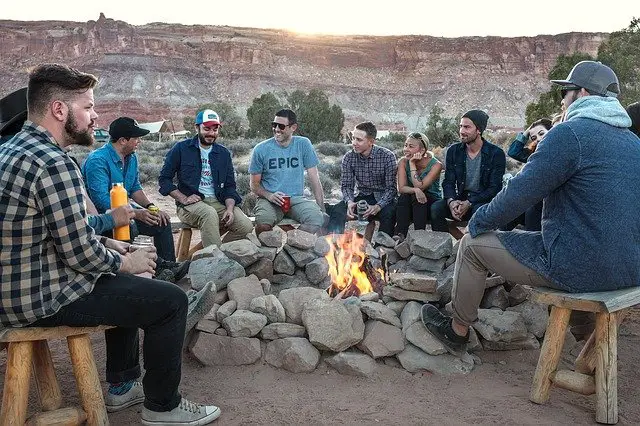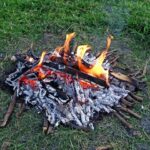If you are into camping, hiking, or just spending time outdoors, you most probably have tried to start a fire in your life. Now I know that is kind of obvious but hear me out.
If you have successfully made a fire before, chances are that you have also produced a fair bit of smoke in the process. What if I told you there is a way to make a fire that produces little to no smoke?
Well, it is possible, and in this article, I will discuss a few methods you can use to make a fire that produces little to no smoke. So, keep reading to find out how you can make a fire a smokeless fire.
More...

Table of Contents
What Causes Fire to Smoke?
Before we get into how to make a smokeless fire, it is essential to understand why fires produce smoke in the first place.
Most people know that smoke is produced when you burn wood. But why does this happen? It all has to do with the chemical composition of wood.
Wood is made up of cellulose and lignin, two slow-burn materials. When you heat the wood, these materials break down and release gasses. These gasses are then combusted, producing smoke and flame.
The amount of smoke produced when burning wood can vary depending on the type of wood and the burning conditions.
For example, hardwoods typically produce more smoke than softwoods. Similarly, green wood or wet wood will produce more smoke than dry wood.
How To Make a Smokeless Fire? - 9 Methods That Work
Now that we know how and why smoke is produced when burning wood, let's look at how you can make a smokeless fire.
Use Dry Wood
If you want to enjoy a smoke-free fire, the first and foremost thing you need is dry wood. If the wood is wet, it will not only produce more smoke but will also be more difficult to light. If you can, try to find wood that has been left to dry in the sun for a few days. This will make it easier to light and produce less smoke.
To start a fire, you will need some kind of kindler. This can be anything from dry leaves to paper. Once you have your kindler, add some small twigs and sticks. As the fire grows, you can add larger pieces of wood.
Use Charcoal
If you're using a grill or barbecue, you can make a smokeless fire by using charcoal. Charcoal produces less smoke than wood and is easier to light.
To start the fire, spread the charcoal in a single layer and light it with a match or lighter. Add some wood to the fire once the charcoal has started to glow.
Always make sure that you use enough charcoal to keep the fire going.
Use a Fireplace Grate
A fireplace grate is a great way to make a smokeless fire. Grates are specially designed to keep logs elevated off the fireplace floor, allowing air to circulate and preventing the buildup of smoke and creosote. Moreover, grates help evenly distribute heat, ensuring that your fire burns evenly and efficiently.
You can buy a fireplace grate at most home improvement stores.
Most importantly, when using a fireplace grate, ensure it is the right size for your fireplace. If it is too small, it will not be effective in preventing smoke from escaping.
Build a Dakota Fire Pit
The Dakota Fire Pit is a type of fire pit used by the Očhéthi Šakówiŋ tribe. Its design is such that it produces very little smoke.
Here are the steps you need to follow to build one:
Select a location that's flat and easy to access.
Dig the fire pit; the deeper, the better since the fire will be contained.
Dig the oxygen supply pit about a foot away from the fire pit.
Make a tunnel to connect the two holes.
Start the fire
The Dakota Fire Pit is a great way to enjoy a smokeless fire because it allows for proper airflow and prevents the wood from smoldering and producing smoke.
Use an Inverted Cone
The inverted cone method is a great way to make a smokeless fire. It works by creating a chimney effect that allows smoke to escape while still providing enough oxygen for the fire to burn.
To start, gather some small twigs and sticks and place them in the center of a firepit. Next, build a cone out of larger sticks and twigs. The cone should be about six inches tall.
Once the cone is built, light it on fire. As the fire burns, it will create a draft that will draw oxygen into the fire and cause the smoke to escape.
Use a Stove
Stoves burn wood more efficiently than open fires, producing less smoke. This is because they are equipped with a damper, allowing you to control the airflow and prevent smoke from escaping.
In addition, stoves typically have a glass door, which further helps prevent smoke from escaping.
To use a stove, simply build a small fire and close the door. Then, adjust the damper, so there is just enough airflow to keep the fire going.
You may need to experiment with the damper settings to find the perfect balance.
Stack Wood Properly
The way you stack wood can have a significant impact on how much smoke is produced. When stacking wood, place the logs parallel to each other with space in between. This will allow air to circulate and prevent the logs from smoldering.
Also, be sure to stack the wood in a dry, well-ventilated area so it can properly dry out.
Use the Correct Fire Starter
If you're using a fireplace, campfire, or stove, it's important to use the correct fire starter. The best fire starters are those that produce little to no smoke. Some good options include:
Dryer lint
Waxed paper
Charcoal starter
If you're using a grill or barbecue, you can use:
Lighter fluid
Propane
Natural gas
Use Fuels That Produce Little Smoke
When choosing a fuel for your fire, selecting one that produces little smoke is important. Some good options include:
Coal
Animal droppings
Gel fuel
Propane
More tips for making a smokeless fire
Keep your fire small - A small fire is less likely to produce smoke than a large one.
Make sure to keep your fire burning - If it starts to smolder, it will produce more smoke. Add wood or charcoal as needed to keep the fire burning brightly.
Have good ventilation - Ensure plenty of airflow around your fire to prevent smoke from building up.
Wind speed - If there is too much wind, it will fan the flames and cause the fire to smoke. Try to find a balance between too little and too much wind.
Use a fireproof cover - If you're using a grill or barbecue, placing a fireproof cover over the top will help prevent smoke from escaping.
Stoke the fire - Use a poker or stick to stir the wood around so it burns evenly. This will also help to prevent smoke from building up.
Benefits of a Smokeless Fire
A smokeless fire has many benefits. Some of these benefits include:
Environmentally Friendly
One of the biggest benefits of smokeless fires is that they're much more environmentally friendly. Because there's no smoke, there's also no pollution. That means smokeless fires are a great way to enjoy a fire without harming the environment.
Better for Your Health
Smokeless fires are also much healthier for you. The lack of smoke means no risk of inhaling harmful toxins. That's why smokeless fires are an excellent option for people with respiratory problems.
More Efficient
If you want your fire to last longer, a smokeless fire is a way to go. Because there's no smoke, there's less heat loss. That means your fire will burn more slowly and evenly, providing you with more heat for a longer period.
Stealthiness
Smokeless fires are also much stealthier than regular fires. For example, you might want to make a fire while camping or hiking but don't want to be seen. A smokeless fire is a perfect solution because no smoke will give you away.
Reduced Smell
When you're trying to enjoy a fire, the last thing you want is for your clothes to smell like smoke. With a smokeless fire, there's no risk of that.
How to Make a Smokeless Fire – Final Thoughts
A smokeless fire is a great way to enjoy all the benefits of a fire without the drawbacks of smoke.
There are several ways to make a smokeless fire, including using the right fuel, building a good stack of wood, and having proper ventilation. Additionally, smokeless fires are environmentally friendly, more efficient, and healthier for you.
So next time you're out camping or enjoying a fire in your backyard, try making a smokeless fire. You'll be glad you did!
- Are Merrell Shoes Good? – An Unbiased Review of Merrell Footwear - December 9, 2023
- Where Are Merrell Shoes Made? - December 9, 2023
- Camping in 40-degree Weather: Tips and Tricks - September 25, 2023

![Does Columbia Omni Heat Work? [Is It Really Work?] Does Columbia Omni Heat Work? [Is It Really Work?]](https://grandcircletrails.com/wp-content/uploads/2022/05/Does-Columbia-Omni-Heat-Work-150x150.jpg)
![How to Make Toast While Camping? [Methods You Need To Try] How to Make Toast While Camping? [Methods You Need To Try]](https://grandcircletrails.com/wp-content/uploads/2022/07/How-to-Make-Toast-While-Camping-150x150.jpg)
![How to Put Out a Fire without Water? [Guide] How to Put Out a Fire without Water? [Guide]](https://grandcircletrails.com/wp-content/uploads/2022/03/How-to-Put-Out-a-Fire-without-Water-2-150x150.jpg)


![How to Dry Tent after Rain? – 2 Proven Methods [Explained] How to Dry Tent after Rain? – 2 Proven Methods [Explained]](https://grandcircletrails.com/wp-content/uploads/2021/08/How-to-Dry-Tent-after-Rain-1-150x150.jpg)